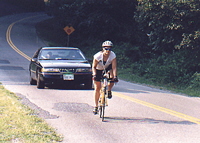by Ann Snoeyenbos
December 2000
Part 1. Training for sleep deprivation
If you have never participated in a race that lasts more than 15 hours you might be concerned about what will happen to you as you race through the night. During your training season it is good to practice training in the nighttime, before dawn, and past the point of general fatigue just to get a sense of how your body and brain reacts. However, because extended periods of sleep deprivation can wreck havoc on your mind and body it is not recommended that you make a habit of getting too little sleep. Human Growth Hormone is maximally produced during REM sleep and since this substance is key to muscle recovery it is vital during periods of heavy training. REM sleep is also the time when the mind processes emotions and events, so you may find that periods of sleep deprivation result in your emotional instability. For example, you may feel overwhelmed by tasks that would otherwise be relatively easy, or you might be grouchy or sad for no reason. (Beware though, this type of moodiness might also signal overreaching or overtraining syndrome so it is a good idea to keep track of how much sleep you're getting.)
Nonetheless, a couple of sessions of swimming, biking, or running in darkness and through the wee hours of the night can provide useful information to you about how your body might react on race day. Calculate the amount of time you expect to spend doing each part of your race to figure out which event(s) you might be doing in the dark. Try to set up your practice sessions in a safe place and let other people know what you are going to be doing. It is not uncommon for an athlete to fall asleep while cycling and fall over, or for an athlete to doze off while running and go off course.
You may experience some or all of the following sensations:
Frequent urination: Cooler night air means you will perspire less. You will need less fluid to stay hydrated through the night but most people don't shift their drinking pattern and so they urinate much more frequently than in the daytime.
Dizziness/disorientation: This is due in large part to the fact that your body has been in motion for many many hours and so you experience a sort of motion sickness or inner ear imbalance. Also, your eyes will need to adjust to the darkness. Shapes and shadows appear completely different from the way they do in daylight and a tired brain might not be able to process the new information about depth and distance as efficiently as it could when you were fresh.
Hallucinations: Again, the brain can be slow in processing new visual information from the eyes. Some hallucinations are really a form of waking dreams - that is to say, you are dozing off while you compete but because you wake up immediately and/or frequently you confuse the dream with reality.
Sleepiness: If you suddenly experience crushing sleepiness you might be behind on calories and/or fluid. Try eating and drinking something and you may find that you feel much better right away. If not, try the 10 minute nap described below, and then resume activity.
Keep in mind, everybody feels better as soon as the sun comes up. When the new day dawns the body's light sensors are reset and the brain understands that it is time to be alert. Athletes will perk at dawn up and many aches and pains seems to disappear with the sunrise, even on a cloudy day. If a nap or sleep break can be timed so that they will wake up at dawn the athlete will feel particularly refreshed upon resuming activity.
Part 2. Sleeping during the race.
During the Deca Ironman (ten times the ironman distance event) athletes were observed to sleep as little as possible in the early days while they were biking and then more and more later in the race while they were running. At the time that seemed to me to be a backward strategy but now I understand why they did that. By pushing the bike portion a bit by reducing their sleep hours they made it possible to take more sleep time during the run which allowed them to spend more time off their feet when the pounding of the road was starting to take a toll.
Each athlete chose sleep intervals that they were familiar with and that had worked for them in the past. Some slept as little as three hours each 24, taking the break when they needed it on no fixed schedule. Another slept five hours each night on a regular schedule, and yet another slept three hours each noon and three more hours at midnight for a total of six hours each and every day.
The idea behind a regular sleep schedule is that your body will rapidly become accustomed to the pattern and it will be easier to both fall asleep and begin performing again because the body will anticipate the intervals.
Many athletes choose to sleep during the hottest part of the day (in a hot climate) and make up time in the night when air temperatures are cooler. Alternately, in a cold climate one would sleep during the coldest time of day and race during the warm time.
A strategy that has been used quite successfully in later stages of a multi-day race is to keep moving when your competition is sleeping, and only sleep once you've built up a suitable margin. Your crew members can engage in seemingly idle chat with the other crews to find out when your opponents are planning to sleep and help you plan your own strategy.
Keep in mind is that all the athletes will slow down significantly during the latter stages of the race. Your goal is to manage your sleep strategy and speed/pacing so that you slow down LESS than the others. The marathon guideline that suggests a runner will slow down 60 seconds per mile in the 2nd half of the race for every 30 seconds per mile they go out too fast in the first half - is magnified manyfold in a multi-day race.
Naps: A short nap of 10 minutes or less will perk an athlete up for at least an hour or two. 10 minutes is the ideal amount of time because anything more is likely to put the athlete into a deeper level of sleep from which it is difficult to emerge without two or more hours of rest. After the 10 minutes most athletes feel quite good, clearheaded and refreshed. A few athletes might feel that their fatigue is worse afterward, however studies have shown that even if they feel groggy their performance will be improved after the nap. The 10 minute rest has been used quite successfully in races lasting 20 or more hours to get athletes through a groggy period and back on track. For multi-day races it is usually sufficient to get the athlete through a tough period so that they can continue until the scheduled period of longer rest or sleep.
Preparing the 10 minute nap: Feet should be elevated 10-90 degrees on a cooler, water jug, chair, or other available prop. Knees can be bent or straight, whichever is more comfortable, but elevating the legs allows fluid to drain out of the legs and ankles and promotes relaxation of the back muscles. The athlete should rest on a somewhat cushioned surface simply so they can relax their entire body, but the goal is not luxury. A piece of cardboard, or a camping mattress is adequate. A small pillow can be used to ensure that the neck muscles relax but is probably not necessary and may be uncomfortable due to the elevated legs. The athlete should be covered with a blanket, towel or other light wrap to keep the body from becoming chilled and stiff, but a heavy blanket is not a good idea as it will induce too deep a sleep.
Foods: The athlete should eat and drink as much as possible/comfortable before the nap because it provides a good opportunity to catch up on calories. If the athlete does not want to eat or drink beforehand it is important to include the nap in the total elapsed time between feedings because their metabolism will still be going full force and calories will be burned even though they are not moving. Some foods contain higher levels of tryptophan (a sleep-inducing amino acid) and should be avoided if sleepiness is a problem for the athlete. These foods include: avocados, bananas, dairy products (cheese, yogurt, milk, etc), dates, eggplant, fish, turkey, walnuts.
Caffeine: Regular drip coffee has more caffeine than drinks made with espresso (cappuccino or latte). A shot of espresso has 89 mg caffeine vs 138 mg caffeine in 6 oz. of drip coffee. Products like caffeinated candies, caffeinated carbohydrate gels, and the like usually have very small amounts of caffeine in them, not enough to really perk up a performance but perhaps enough to disrupt sleep. One should avoid consuming additional caffeine in the hours before a scheduled sleep break. However, if the athlete's break will last less than 20 minutes a large dose of caffeine could be given immediately before the break, understanding that caffeine takes about 20 minutes to enter the bloodstream and take effect.
Guarana: This is a product advertised as an herbal alternative to caffeine. In its pure form it may be, but many guarana preparations sold in health food stores contain ephedra or ephedrine which is a banned substance under the International Olympic Committee rules (and illegal for sale in many states of the USA).
Author

 Ann Snoeyenbos (Snow-en-boss) is a 36 year old reference librarian living and working full-time in New York City. She trains before and after work, avoiding periods of high automobile traffic and pollution. Extensive physiological testing has demonstrated that Ann is physically unremarkable. Nonetheless, Ann has completed four ironman distance races, two double ironman distance races, and numerous single-sport ultra-endurance events.
Ann Snoeyenbos (Snow-en-boss) is a 36 year old reference librarian living and working full-time in New York City. She trains before and after work, avoiding periods of high automobile traffic and pollution. Extensive physiological testing has demonstrated that Ann is physically unremarkable. Nonetheless, Ann has completed four ironman distance races, two double ironman distance races, and numerous single-sport ultra-endurance events.
|



